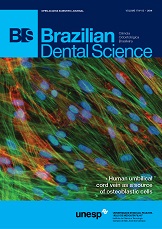The finite element methods on oral rehabilitation: New trend for endodontically treated teeth
DOI:
https://doi.org/10.14295/bds.2014.v17i3.1001Resumo
The aim of this study is to present the applicability of Finite element analysis (FEA) in oral rehabilitation, especially in endodontically treated teeth, based on its indication, methods, advantages and limitations through a literature review. The search was conducted on National Library of Medicine’s Pub Med, Google search and Science Direct databases including the keywords “finite element analysis”, “oral rehabilitation” and “endodontics”. A total of 412 articles were found, 42 were carefully selected by two subject matter experts for discussion including 21 articles focusing on the applicability of FEA to endodontically treated teeth. The FEA is a versatile, low-cost and efficient approach for reliable evaluation of complex structures, as oral rehabilitation treatments.
Keywords: Endodontics; Finite element analysis; Oral rehabilitation.
Downloads
Downloads
Arquivos adicionais
Publicado
Como Citar
Edição
Seção
Licença
TRANSFERÊNCIA DE DIREITOS AUTORAIS E DECLARAÇÃO DE RESPONSABILIDADE
Toda a propriedade de direitos autorais do artigo "____________________________________________________________________" é transferido do autor(es) para a CIÊNCIA ODONTOLÓGICA BRASILEIRA, no caso do trabalho ser publicado. O artigo não foi publicado em outro lugar e não foi submetido simultaneamente para publicação em outra revista.
Vimos por meio deste, atestar que trabalho é original e não apresenta dados manipulados, fraude ou plágio. Fizemos contribuição científica significativa para o estudo e estamos cientes dos dados apresentados e de acordo com a versão final do artigo. Assumimos total responsabilidade pelos aspectos éticos do estudo.
Este texto deve ser impresso e assinado por todos os autores. A versão digitalizada deverá ser apresentada como arquivo suplementar durante o processo de submissão.




























